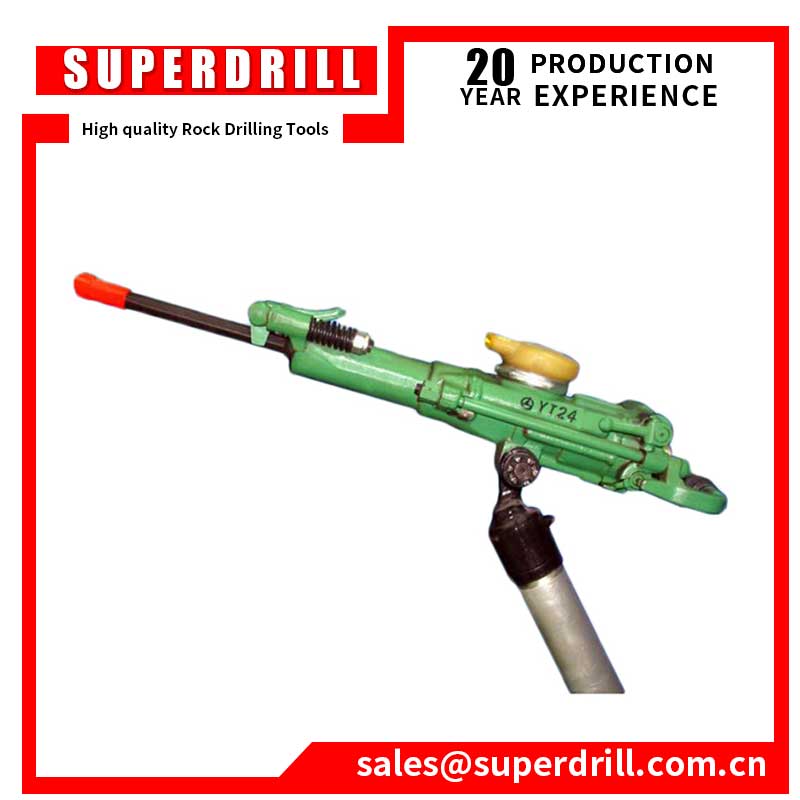Drilling into rock without causing cracks requires careful planning, the right tools, and a precise technique. Whether for quarrying, mining, or construction, achieving a clean drill in rock can be essential for the integrity and aesthetics of the project. Here's a step-by-step guide on how to drill into rock without cracking it, with insights from Superdrill Equipment, a specialized manufacturer and supplier of rock drilling tools, stone, demolition tools, and consumables with 20 years of experience.
 Air Leg Rock Drill
Air Leg Rock Drill
Step 1: Choose the Right Tools
High-Quality Drill Bits
Select high-quality drill bits specifically designed for rock drilling. Carbide-tipped or diamond drill bits are ideal for this task due to their durability and ability to withstand the hardness of rock.
Drilling Equipment
Superdrill Equipment offers a range of specialized rock drilling tools and consumables, ensuring you have the right equipment for the job. Their products are designed to minimize the risk of cracking and ensure efficient drilling.
Step 2: Prepare the Rock Surface
Clean the Surface
Ensure the rock surface is clean and free of debris. This helps the drill bit to make proper contact and reduces the risk of slipping, which can cause cracks.
Mark the Drilling Point
Use a permanent marker or chalk to mark the exact point where you intend to drill. This helps in maintaining precision and prevents unnecessary stress on the rock surface.
Step 3: Secure the Rock
Stabilize the Rock
If the rock is movable, secure it in place using clamps or a vice. Ensuring the rock is stable reduces vibrations and movement, which can lead to cracking.
Step 4: Drill Pilot Holes
Start with a Small Bit
Begin by drilling a small pilot hole using a smaller diameter bit. This initial hole will guide the larger drill bit and reduce the stress on the rock.
Slow and Steady
Drill at a slow speed to maintain control and reduce heat build-up, which can cause the rock to expand and crack. Apply consistent, gentle pressure.
Step 5: Gradual Drilling
Increase Bit Size Gradually
After drilling the pilot hole, switch to a larger bit and gradually increase the hole size. Avoid jumping to a much larger bit immediately, as this can create excessive pressure and cause cracks.
Cooling the Bit
Keep the drill bit cool by periodically stopping and allowing it to cool down. Alternatively, use water to cool the bit and the drilling area. This prevents thermal expansion and reduces the risk of cracking.
Step 6: Maintain Proper Technique
Steady Hand
Maintain a steady hand and apply even pressure throughout the drilling process. Sudden movements or jerking can create stress fractures in the rock.
Use the Right Speed and Pressure
Adjust the drill's speed and pressure according to the rock type. Softer rocks may require lower speeds and less pressure, while harder rocks may need higher speeds but consistent pressure.
Step 7: Monitor and Adjust
Check for Cracks
Regularly inspect the rock for any signs of cracking as you drill. If you notice any cracks forming, stop immediately and reassess your technique.
Adjust as Needed
If cracks start to appear, consider reducing the drill speed, using a smaller bit, or applying a cooling method more frequently.
Step 8: Finishing Touches
Clean the Drilled Hole
After successfully drilling the hole, clean out any debris or dust using compressed air or a brush. This ensures the hole is clean and ready for any further use.
Inspect the Rock
Finally, inspect the rock to ensure no cracks have formed during the drilling process. A clean, crack-free hole is the goal, indicating successful drilling.
Expert Insights from Superdrill Equipment
Superdrill Equipment, with 20 years of experience in manufacturing and supplying rock drilling tools, stone, demolition tools, and consumables, emphasizes the importance of using the right tools and techniques. Their high-quality products are designed to minimize the risk of cracking and ensure efficient, precise drilling. By following the steps above and utilizing Superdrill Equipment's specialized tools, you can achieve optimal results in your rock drilling projects.
In conclusion, drilling into rock without causing cracks involves selecting the right tools, preparing the rock surface, securing the rock, and using a gradual, controlled drilling technique. By following these steps and leveraging the expertise of manufacturers like Superdrill Equipment, you can ensure a successful and crack-free drilling process.
 Mobile:
Mobile: E-mail:
E-mail: